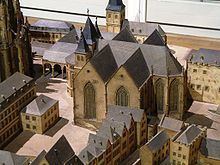 | ||
Similar St George's Church, Basilica of St Cunibert, St Maria im Kapitol, Deutz Abbey, St Johann Baptist | ||
St maria ad gradus top 6 facts
St. Maria ad Gradus ("Our Lady of the Steps", also colloquially called Mariengraden in German language) is the name of a former church located East of the Cathedral of Cologne, Germany, situated between the cathedral and the Rhine.
Contents
Founded by Herman II, Archbishop of Cologne, the church was the burial site of blessed Richeza of Lotharingia (died March 1063), a former Queen of Poland and a grandchild of Otto II, Holy Roman Emperor and his wife Theophanu. The Romanesque building, 55m long and 42m wide, was probably completed of Archbishop Anno II in 1075, when the relics of St. Agilulfus of Cologne (died 750) were transferred there. Already in 1080 it burned down, but was rebuilt in 1085 and later expanded.
Since, the remains of Richeza and others were transferred to the cathedral which had been commenced in 1248. Konrad von Hochstaden was canon of St. Maria ad Gradus and Archbishop of Cologne during that time, from 1238 to 1261.
Following the French occupation of the Rhineland since 1794, monasteries and cleric organisations had to be dissolved, churches were left abandoned. As it was too close to other churches (Groß St. Martin, Cathedral, St. Andreas), Maria ad Gradus was demolished in 1817 and 1827 when the area surrounding the Cathedral was cleared to make way for its restoration and completion. Only small parts remain, like a column.
